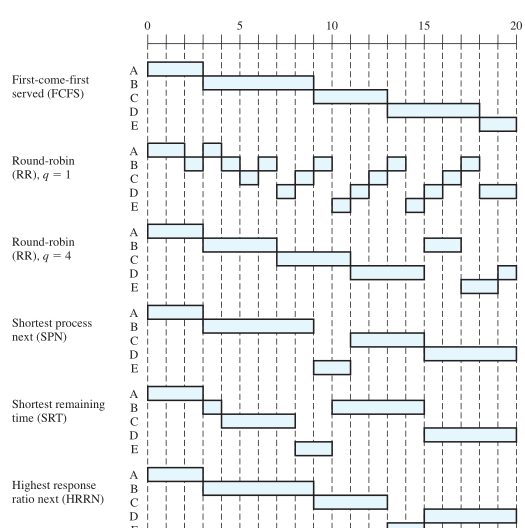
- •1)Introduction to computer architecture. Organizational and methodical instructions
- •2)Interrupts. Interrupts and the Instruction Cycle. Interrupt Processing. Multiprogramming.
- •3)Introduction to Operating systems (os), general architecture and organization.
- •Introduction to os Organization
- •4)Major Achievements of os: the Process; Memory Management; Information Protection and Security; Scheduling and Resource Management; System Structure.
- •5)Process Description and Control
- •6)Process States. Process Models.The Creation and Termination of Processes.Suspended Processes.
- •7)Process Description. Operating System Control Structures.Process Switching.
- •8)Memory Management
- •10)Memory Management Requirements. Relocation. Protection. Sharing.
- •11.Memory Partitioning. Relocation.
- •12) Virtual Memory. Paging. Segmentation. Combined Paging and Segmentation.
- •13) Replacement Policy. First-Come-First-Served, Round-Robin algorithms
- •14) Replacement Policy. Shortest Process Next, Shortest Remaining Time algorithms.
- •15)File Organization and Access.
- •16.Secondary Storage Management.
- •17.Short history of Windows, general architecture, software configuration, registry, main administration tools; the boot process.
- •18. Mutual Exclusion and Synchronization
- •19. Programming tools for mutual exclusion: locks, semaphores
- •20. Deadlock: general principle, synchronization by events, monitors, the producer/consumer example, the dining philosophers’ problem
- •21. Disk scheduling. Raid-arrays
- •22. Input-output management
- •23. Page replacement algorithms
- •24. Mutual exclusion and synchronization
- •25. Overview of computer hardware
- •26.Uniprocessor scheduling.
- •27.Implementation of disk scheduling algorithms sstf, scan.
- •28. Implementation of disk scheduling algorithm look.
- •29. Implementation of lru replacement algorithm.
- •31.Briefly describe basic types of processor scheduling. Examples
- •I/o scheduling
- •32.What is the difference between preemptive and nonpreemptive scheduling? Examples.
31.Briefly describe basic types of processor scheduling. Examples
The aim of processor scheduling is to assign processes to be executed by the processor or processors over time,in a way that meets system objectives,such as response time, throughput, and processor efficiency. In many systems, this scheduling activity is broken down into three separate functions: long-, medium- , and short- term scheduling.The names suggest the relative time scales with which these func- tions are performed. Aim of Scheduling
• Assign processes to be executed by the processor(s)
• Response time
• Throughput
• Processor efficiency
Long-term scheduling is performed when a new process is created. This is a decision whether to add a new process to the set of processes that are currently active.Medium-term scheduling is a part of the swapping function.This is a decision whether to add a process to those that are at least partially in main memory and therefore available for execution. Short-term scheduling is the
actual decision of which ready process to execute next.
I/o scheduling
The decision as to which process’s pending I/O request shall be
handled by an available I/O device.


Scheduling affects the performance of the system because it determines which processes will wait and which will progress. Fundamentally, scheduling is a matter of managing queues to minimize queuing delay and to optimize performance in a queuing environment.
32.What is the difference between preemptive and nonpreemptive scheduling? Examples.
The Scheduling algorithms can be divided into two categories with respect to how they deal with clock interrupts.
Nonpreemptive Scheduling A scheduling discipline is nonpreemptive if, once a process has been given the CPU, the CPU cannot be taken away from that process. Following are some characteristics of nonpreemptive scheduling
In nonpreemptive system, short jobs are made to wait by longer jobs but the overall treatment of all processes is fair.
In nonpreemptive system, response times are more predictable because incoming high priority jobs can not displace waiting jobs.
In nonpreemptive scheduling, a schedular executes jobs in the following two situations.
When a process switches from running state to the waiting state.
When a process terminates.
Preemptive Scheduling.A scheduling discipline is preemptive if, once a process has been given the CPU can taken away.
The strategy of allowing processes that are logically runable to be temporarily suspended is called Preemptive Scheduling and it is contrast to the "run to completion" method.
Nonpreemptive: In this case, once a process is in the Running state, it continues to execute until (a) it terminates or (b) it blocks itself to wait for I/O or to request some operating system service.
• Preemptive: The currently running process may be interrupted and moved to the Ready state by the operating system.The decision to preempt may be performed when a new process arrives; when an interrupt occurs that places a blocked process in the Ready state;or periodically,based on a clock interrupt.Preemptive policies incur greater overhead than nonpreemptive ones but may provide better service to the total population of processes,because they prevent any one process from monopolizing the processor for very long. In addition, the cost of preemption may be kept relatively low by using efficient process-switching mechanisms (as much help from hardware as possible) and by providing a large main memory to keep a high percentage of programs in main memory.
As we describe the various scheduling policies,we will use the set of processes
